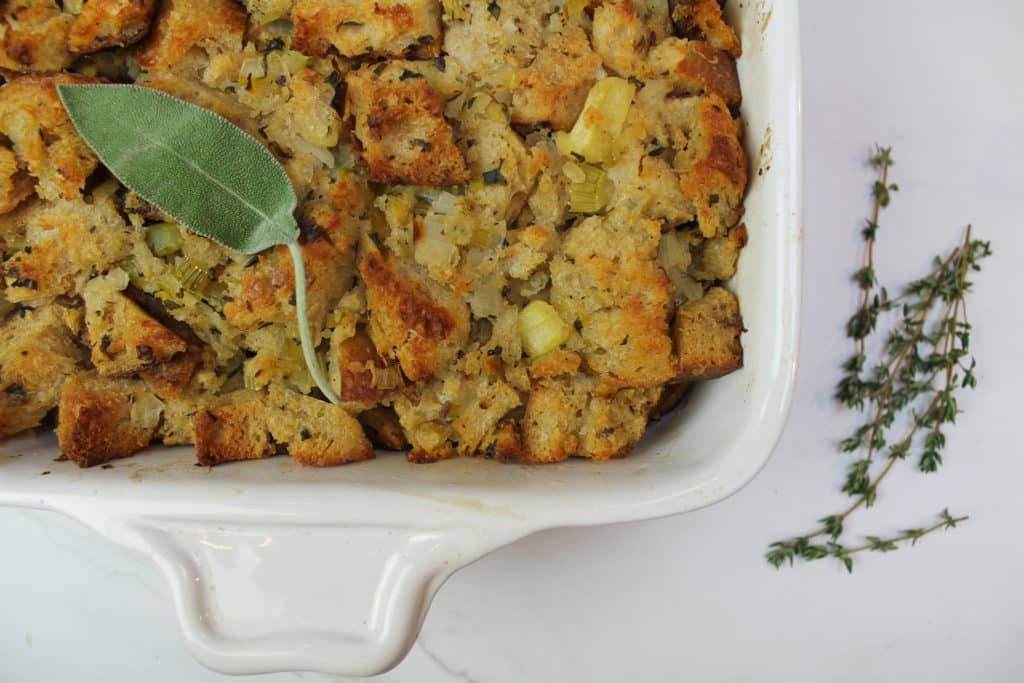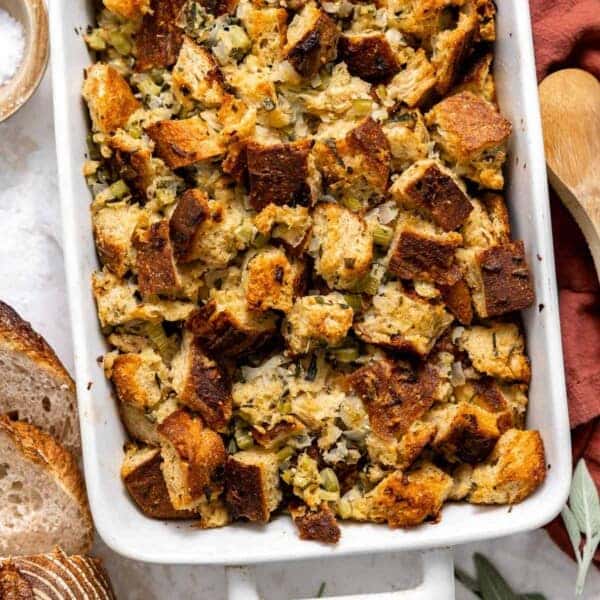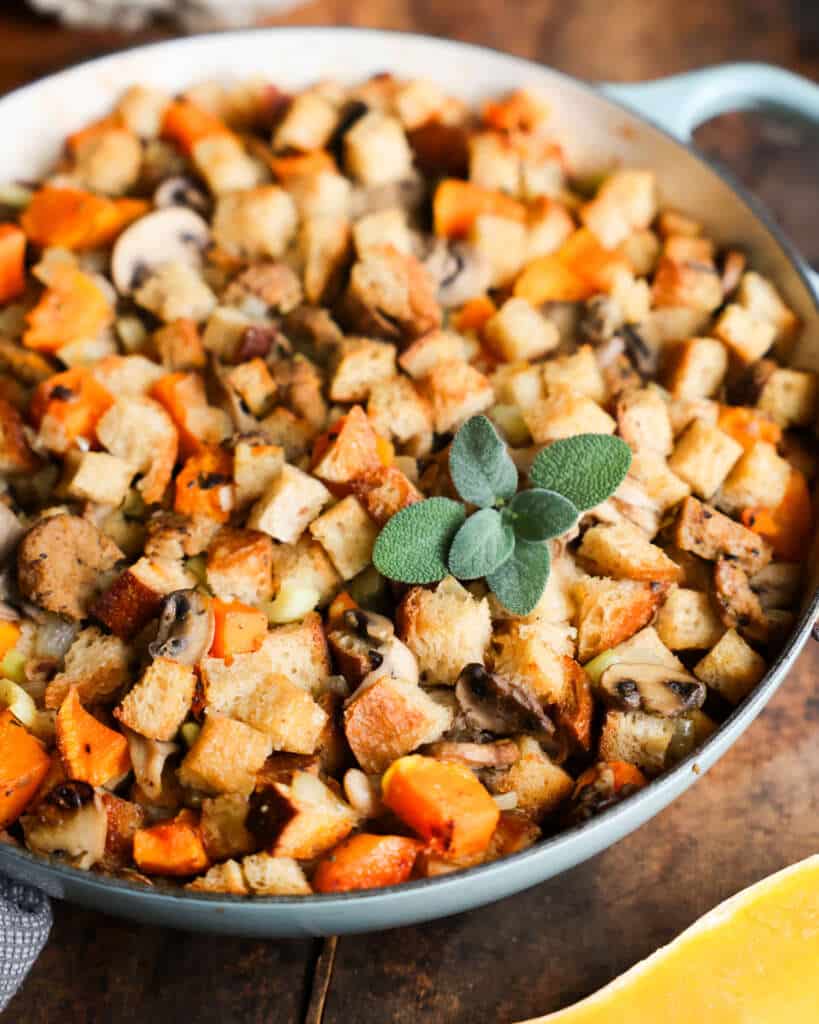How to Make the Best Sourdough Stuffing with Boudin Bread
When it comes to holiday dinners, stuffing holds a special place at the table—a warm, flavorful companion to turkey, gravy, and cranberry sauce. But not all stuffing is created equal. If you’re looking for a recipe that stands out, sourdough stuffing with Boudin bread is a game-changer. Its tangy flavor, dense texture, and ability to hold up to savory ingredients make it the ultimate choice for a holiday staple.
This guide will walk you through every step of creating the perfect sourdough stuffing, from preparing the bread to baking it to perfection. Whether you’re a seasoned cook or tackling stuffing for the first time, this recipe will ensure your dish is a standout hit.
Why Boudin Sourdough Bread is Perfect for Stuffing
Unmatched Flavor
Boudin sourdough bread, crafted by the iconic San Francisco bakery, is renowned for its slightly tangy flavor. This distinct taste adds a layer of complexity to stuffing that traditional white or whole wheat bread can’t match.
Ideal Texture
Its dense crumb and chewy crust ensure that it absorbs just the right amount of moisture without turning soggy—a critical feature for stuffing that’s moist on the inside and crispy on top.
Versatility
Boudin sourdough pairs beautifully with a variety of ingredients, from classic aromatics like onions and celery to sweet elements like apples and cranberries.
Ingredients Overview
Primary Ingredients
- Boudin Sourdough Bread: About one loaf, cut into 1-inch cubes. Use fresh bread that you dry yourself or purchase pre-dried cubes.
- Aromatics:
- Onions: One medium, finely chopped.
- Celery: Three stalks, diced.
- Garlic: Two cloves, minced.
- Liquids:
- Chicken or Turkey Broth: 2 cups (adjust for desired moisture).
- Butter: 1/2 cup (melted).
- Optional: 1/4 cup white wine for added depth.
- Herbs and Spices:
- Fresh Sage: 1 tablespoon, chopped.
- Thyme: 1 teaspoon, dried or fresh.
- Parsley: 2 tablespoons, chopped.
- Salt and Pepper: To taste.
Optional Additions
- Proteins:
- Sausage (browned and crumbled).
- Bacon (cooked and chopped).
- Fruits and Nuts:
- Diced apples or dried cranberries for a touch of sweetness.
- Chopped walnuts or pecans for crunch.
- Dietary Substitutions:
- Use gluten-free sourdough or vegetable broth for dietary restrictions.
Preparing the Boudin Sourdough Bread
Drying the Bread
Dry bread is the foundation of great stuffing—it ensures the cubes absorb the flavorful broth without becoming mushy.
- Fresh Bread: If using fresh Boudin sourdough, cut it into 1-inch cubes and spread them in a single layer on a baking sheet.
- Oven-Drying: Bake at 250°F (120°C) for 20–30 minutes until the cubes are firm and slightly golden. Let them cool completely before using.
- Pre-Dried Cubes: If you’re short on time, pre-dried sourdough cubes are a convenient alternative.
Cooking Instructions for the Best Sourdough Stuffing
Stuffing is a holiday classic, and sourdough stuffing elevates it to gourmet status with its tangy flavor and hearty texture. Follow these detailed steps to ensure your dish is perfectly seasoned, moist, and golden brown on top.
Step 1: Sauté Aromatics
The aromatics—onions, celery, and garlic—lay the flavor foundation for your stuffing. Here’s how to get them just right:
- Heat the Butter:
- Melt 2 tablespoons of butter in a large skillet over medium heat.
- Allow the butter to fully melt and become slightly frothy before adding ingredients.
- Cook the Vegetables:
- Add chopped onions, diced celery, and minced garlic to the skillet.
- Stir occasionally to ensure even cooking and prevent sticking.
- Cook for 5–7 minutes until the onions turn translucent, the celery softens, and the garlic becomes fragrant.
- Remove from Heat:
- Once the aromatics are tender and aromatic, remove the skillet from the heat and set it aside to cool slightly.
Pro Tip: You can add a pinch of salt while sautéing to enhance the natural sweetness of the onions and celery.
Step 2: Combine Bread and Herbs
Bringing the bread cubes and herbs together ensures every bite is infused with flavor.
- Prepare the Mixing Bowl:
- In a large mixing bowl, add the dried sourdough bread cubes.
- Ensure the cubes are evenly sized to allow for consistent absorption of liquid.
- Add the Aromatics:
- Pour the sautéed onions, celery, and garlic over the bread cubes.
- Mix in the Herbs:
- Add chopped sage, thyme, and parsley to the bowl.
- Gently toss everything to distribute the herbs and aromatics evenly.
Pro Tip: If using dried herbs instead of fresh, reduce the quantities slightly as dried herbs have a more concentrated flavor.
Step 3: Add Liquids
Moisture is key to great stuffing, but balance is essential to avoid sogginess.
- Prepare the Liquid Mixture:
- In a separate bowl, combine 2 cups of chicken or turkey broth with 1/2 cup of melted butter.
- For an added layer of depth, stir in 1/4 cup of white wine.
- Pour Gradually:
- Slowly drizzle the liquid mixture over the bread cubes while gently tossing.
- Stop when the bread is moist but not drenched. It should hold its shape when pressed lightly.
Pro Tip: Add the liquid in batches and assess the texture as you go to prevent over-soaking.
Step 4: Bake to Perfection
Baking transforms your mixture into a beautifully golden, flavorful stuffing.
- Prepare the Baking Dish:
- Grease a 9×13-inch casserole dish with butter or nonstick spray to prevent sticking.
- Transfer and Cover:
- Spread the stuffing mixture evenly in the dish.
- Cover the dish tightly with aluminum foil to retain moisture during the initial baking stage.
- Bake Covered:
- Preheat your oven to 350°F (175°C).
- Bake the covered stuffing for 30 minutes to allow the flavors to meld and the bread to soften.
- Crisp the Top:
- Remove the foil and bake uncovered for an additional 15–20 minutes. This step creates the perfect golden-brown crust on top.
Pro Tip: For an extra-crispy top, brush a little melted butter over the surface before the final baking stage.
Variations and Customizations
Sourdough stuffing is incredibly versatile, and you can easily tweak the recipe to suit your taste or dietary preferences.
Enhancing Flavor Profiles
- Savory Additions: Browned sausage, pancetta, or crispy bacon add richness and depth.
- Sweet Twists: Incorporate diced apples, dried cranberries, or golden raisins for a festive touch.
- Herbal Variations: Add rosemary, tarragon, or even a sprinkle of nutmeg for unique flavor layers.
Alternative Diets
- Gluten-Free: Use gluten-free sourdough bread cubes to accommodate dietary restrictions.
- Vegan: Substitute butter with vegan margarine and use vegetable broth instead of chicken or turkey stock.
Serving Suggestions
Holiday Pairings
Sourdough stuffing pairs beautifully with other traditional holiday dishes:
- Roast Turkey: The stuffing’s tangy and savory notes perfectly complement the turkey’s rich flavor.
- Mashed Potatoes: Serve alongside creamy mashed potatoes for a classic combination.
- Cranberry Sauce: The sweet-tart sauce provides a refreshing contrast to the stuffing’s earthiness.
Presentation Tips
- For a rustic touch, serve the stuffing directly from a cast-iron skillet or a ceramic baking dish.
- Garnish with freshly chopped parsley or whole sage leaves for an elegant finish.
Tips for Success
Common Mistakes to Avoid
- Over-Soaking Bread: Adding too much liquid can result in mushy stuffing. Pour gradually and mix well to control moisture levels.
- Uneven Seasoning: Ensure the bread cubes, herbs, and aromatics are thoroughly mixed to distribute flavors evenly.
- Skipping the Drying Step: Using undried bread leads to soggy results. Properly dried bread cubes are essential for texture.
Pro Tips for Preparing in Advance
- Dry Bread Cubes Ahead: Prepare and store dried bread cubes in an airtight container for up to a week to save time.
- Assemble Early: Combine all ingredients except the liquid and refrigerate. Add the broth mixture just before baking.
- Reheating Leftovers: Cover with foil and reheat in a 325°F (160°C) oven for 10–15 minutes to retain moisture and freshness.
Frequently Asked Questions (FAQs)
1. Why Use Boudin Sourdough Bread for Stuffing?
Boudin’s sourdough is dense enough to absorb liquid without falling apart and has a tangy flavor that elevates the dish.
2. Can I Prepare Stuffing Ahead of Time?
Yes, you can assemble the stuffing up to 24 hours in advance. Cover and refrigerate, then bake before serving.
3. What Makes Sourdough Better Than Other Bread Types?
Sourdough’s firm texture and natural acidity provide a flavor depth and structure that softer breads can’t match.
4. Can I Freeze Sourdough Stuffing?
Absolutely! Freeze fully baked stuffing in an airtight container for up to one month. Reheat in the oven at 350°F (175°C) until warmed through.
5. Is This Recipe Gluten-Free?
Not as written, but it can be adapted by using gluten-free sourdough bread.
Conclusion
Sourdough stuffing made with Boudin bread is a standout holiday side dish that’s as versatile as it is delicious. Its tangy flavor, hearty texture, and ability to pair with savory and sweet ingredients make it a must-have on your menu.
Ready to wow your guests? Try this recipe and experiment with your unique variations. And don’t forget to share your results or ask questions in the comments below—happy cooking!



